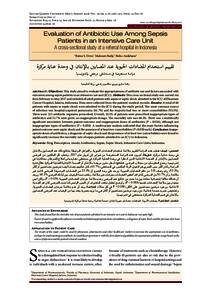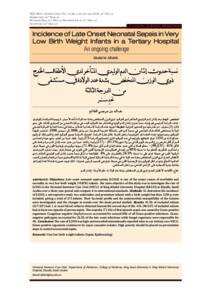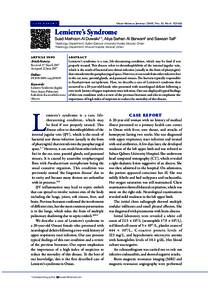Document
Evaluation of antibiotic use among sepsis patients in an intensive care unit : a cross-sectional study at a referral hospital in Indonesia.
Identifier
DOI: 10.18295/squmj.2018.18.03.017
Contributors
Radji, Maksum., Author
Andalusia, Rizka., Author
Other titles
تقييم استخدام المضادات الحيوية عند المصابين بالإنتان في وحدة عناية مركزة : دراسة مستعرضة في مستشفى مرجعي بإندونيسيا
Publisher
College of Medicine, Sultan Qaboos University.
Gregorian
2018-08
Language
English
English abstract
Objectives: This study aimed to evaluate the appropriateness of antibiotic use and factors associated with outcomes among sepsis patients in an intensive care unit (ICU). Methods: This cross-sectional study was carried out from February to May 2017 and included all adult patients with sepsis or septic shock admitted to the ICU of Dharmais Cancer Hospital, Jakarta, Indonesia. Data were collected from the patients' medical records. Results: A total of 60 patients with sepsis or septic shock were admitted to the ICU during the study period. The most common source of infection was hospital-acquired pneumonia (61.7%) and the majority had two or more comorbidities (93.3%). There were 115 antibiotic regimens prescribed. Overall, 33.3% of patients were prescribed inappropriate types of antibiotics and 51.7% were given an inappropriate dosage. The mortality rate was 68.3%. There was a statistically significant association between patient outcome and inappropriate doses of antibiotics (P = 0.034), although not inappropriate types of antibiotics (P = 0.050). A multivariate analysis indicated that the main factors influencing patient outcome were septic shock and the presence of at least two comorbidities (P <0.050 each). Conclusion: Inappropriate doses of antibiotics, a diagnosis of septic shock and the presence of at least two comorbidities were found to significantly increase the mortality rate of sepsis patients admitted to an ICU in Indonesia
Member of
Resource URL
Citation
Dewi, Ratna S., Radji, Maksum, & Andalusia, Rizka (2018 Evaluation of Antibiotic Use Among Sepsis Patients in an Intensive Care Unit : A cross-sectional study at a referral hospital in Indonesia. SQU Medical Journal,18 (3), 367–373.
Arabic abstract
الهدف: هدفت هذه الدراسة لتقويم ملائمة استخدام المضادات الحيوية، والعوامل المرتبطة بنتائج ذلك عند المصابين بالإنتان في وحدة عناية مركزة. الطريقة: أجريت هذه الدراسة المستعرضة من فبراير إلى أبريل عام 2017، وشملت كل البالغين من المرضى المصابين بالإنتان أو الصدمة الانتانية الذين أدخلوا في وحدة العناية المركزة في مستشفى دهارمياس لعلاج للسرطان بجاكارتا في إندونيسيا، وجمع المعلومات من سجلات المرضى. النتائج: أدخل ستون مريضا بالإنتان أو الصدمة الانتانية للعناية المركزة خلال فترة الدراسة. وكان أكبر سبب العدوى هو التهاب الرئة المكتسب في المستشفى (%61.7)، كان غالبهم مصابا أيضا بمرضين مصاحبين أو أكثر (93.3%). وتم وصف 115 من نظم المضادات الحيوية. ووجد على وجه العموم أن %33.3 من المضادات الموصوفة للمرضى كانت غير ملائمة، وأن %51.7 من المرضى كانوا قد أعطيوا المضادات بجرعات غير ملائمة. وبلغت نسبة الوفيات بين أولئك المرضى %68.3. ووجد أن هنالك علاقة إحصائية معتدة بين ما حدث من نتائج عند المرضى وعدم ملائمة جرعات المضادات الحيوية (0.034 = P)، ولكن ليس بينها وبين ملائمة المضادات نفسها (0.050 = P ) وأوضح تحليل متعدد المتغيرات أن السبب الرئيس لما حدث للمرضى كان هوا الانتانية، ووجود مرضين مصاحبين على الأقل (0.050> P في كل حالة). الخلاصة: وجد أن ملائمة جرعات المضادات الحيوية، وتشخيص حدوث صدمة إنتانية، مع وجود مرضين مصاحبين أو أكثر هي ما يزيد بصورة يعتد بها من الوفيات عند المرضى المصابين بالإنتان في قسم للعناية المركزة بمستشفى في اندونيسيا
Category
Journal articles



